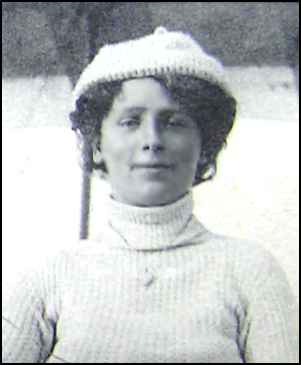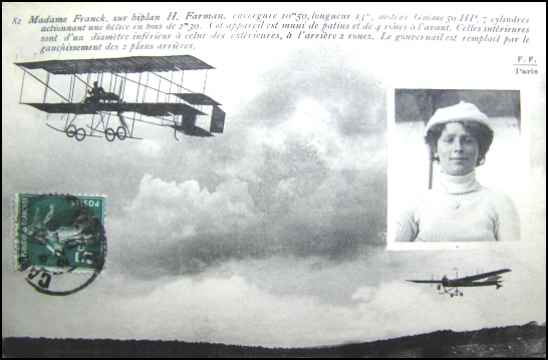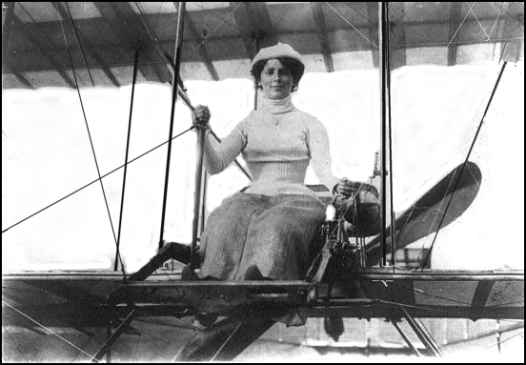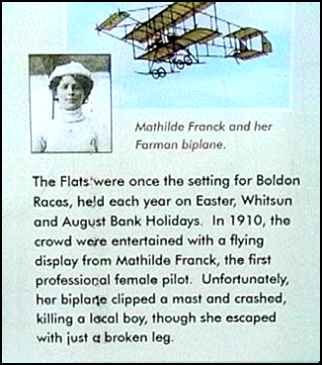
1866-1956 AKA Rosalind Mathilde Franck |
 |
 |
|
Madame Franck, sur biplan H. Farman, envergure 10m50, longeur 13m, moteur Gnôme 50 HP, 7
cylindres actÍonnant une hélice en bois de 2m30. Cet appareil est muni de patins et de 4 roùes à l'avant. Celles intérieures sont d'un
diamètre infèrieur à celui des extérieures, à l'arrière 2 roues. Le gouvernail est remplacé par le gauchissement des 2 plans arrières.
Mrs Franck, on an H. Farman biplane. Wingspan 10meters 50 centimeters, length 13meters, Gnôme 50 HP engine, with 7 cylinders turning a wooden propeller of 2 meters 30 centimeters. This apparatus is provided with skids and 4 wheels in front. The interior (inside) ones are of a smaller diameter than the exterior ones. There are 2 wheels in back. The rudder is replaced by the warping of the 2 back planes. Interestingly, this description does not really fit this airplane. The comment about the rudder is correct, as she earlier flew a plane with a Forward rudder like the Wright Flier, which is missing on this aircraft. On the other hand, there are no rear wheels on the one in this picture, though the earlier one with forward rudder did have two rear wheels. On this aircraft, the rear two wheels have been replaced by a skid, apparently. |
 |
Library of Congress Collection, 4-1-11 |
|
by Mathilde Franck from Colliers Magazine 30 September 1911 Transcribed by Dave Lam, 1-9-04 Another experience, much less exciting, but most delicious, was the flight which Henry Farman gave my husband and me to make the record for two passengers. I was seated on a very comfortable little seat and leaned against the reservoir, and for a space of an hour and a quarter I was able to meditate, dream, and even take notes which I carefully preserve. One day that I shall long remember was that of my first public flight. Naturally the apparatus had been delayed on the road. I only got it at the last moment, when it was just time to mount. And yet my troubles were only beginning. The crowd could not understand that the wind was blowing a gale and that the aerodrome was relatively no bigger than a pocket handkerchief, that it was surrounded with houses and cut in two by a railway, and that it was dangerous to venture out in such circumstances. To cut the story short, in the evening the wind having gone down a bit, I consented to come out in order to escape the cries and howls of the public and the threats of the managers. I flew at will and made my way towards the sea, where there were at least no more obstacles or chimneys. But a fog came on and thickened so that I lost my way. I sought a meadow, and in spite of the fright of the horses browsing in it, came to earth without mishap. I heard outcries and the sound of motor horns and I saw the managers coming with faces of dismay at my long absence. They expected to find me lying under my machine! I had to listen to the expostulations of the directors of the show. They threatened to cancel my contract if I did not fly exclusively within their pocket handkerchief enclosure. They knew nothing of the risks, but the accident which nearly killed me revealed these to them. The other side. In a word, aviation in itself is wonderful, but alas! All that surrounds it from the very first, from the moment when one has to await ones turn for a lesson and many other annoyances, the delay in the delivery of a machine, the managers who require you to fly no matter what the wind, and the frequent difficulty in getting paid. That is the other side of the shield. |
 |
Via email from Robin Coombes, 7-26-05 Back in 1910 at such an event the crowd were entertained with a flying display by the first female professional pilot, Mathilde Franck. Tragically, disaster struck, the biplane crashed and killed a local boy, Mathilde escaped with just a broken leg. Kind Regards Robin |
|
|
|
In August 1910, she thrilled spectators when she took off in a bi-plane from Boldon Flats. But it was a flight that ended in tragedy, when she crashed and killed a young boy. She herself escaped, albeit injured, and the incident effectively ended her ambition to be on a par with some of aviation's earliest male pioneers. Yet today, her feat is virtually forgotten locally. The location from which she took off is an everyday field where cows graze. "It's such a shame. There is absolutely no evidence that it ever happened," said Joan Atkinson. "It's not known about in local schools, there's no plaque – unless something is done, it will all get forgotten about." Joan and fellow East Boldon resident Peter Skevington recently set about trying to find out more about Madame Franck, but it has been an uphill struggle. To read the rest of this fascinating article, click on the title. |
|
Personal communication from Robin Coombes, 7-26-05 Editor's Note: If you have any information on this pioneer aviator please contact me. E-mail to Ralph Cooper |


|